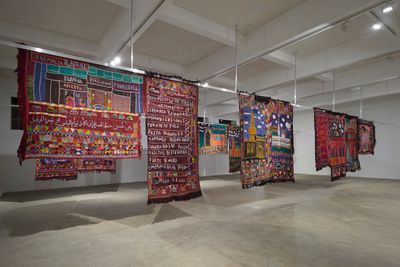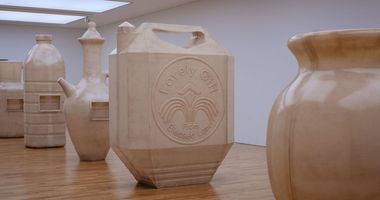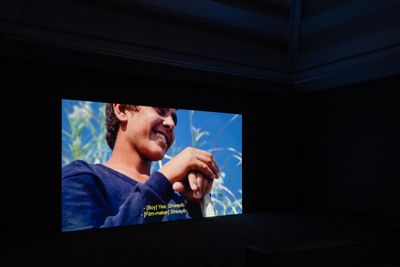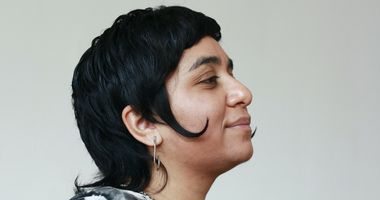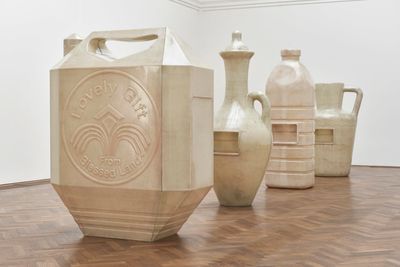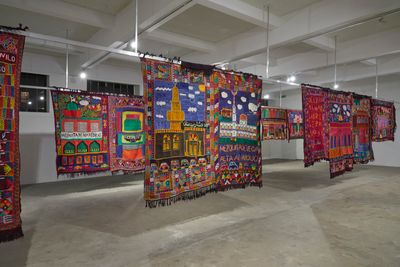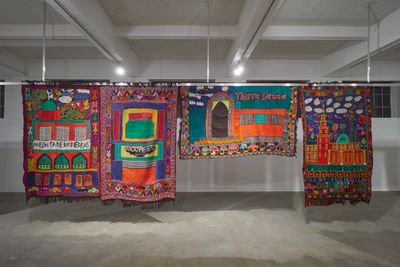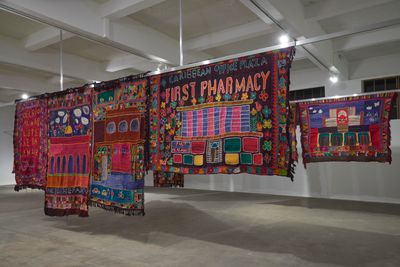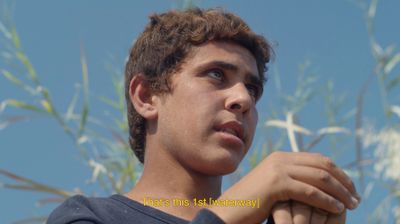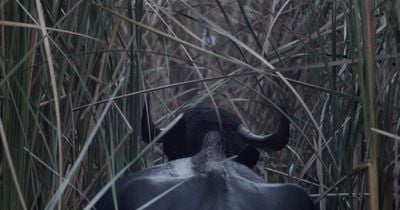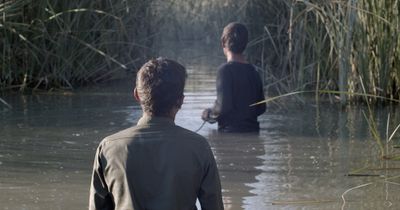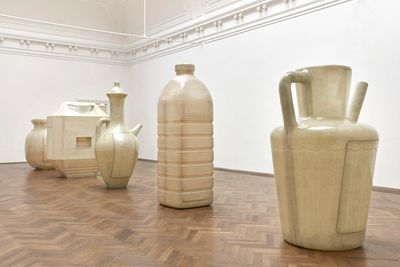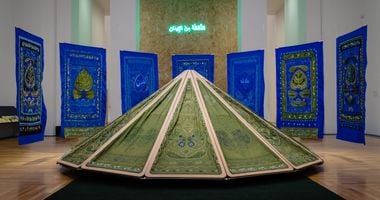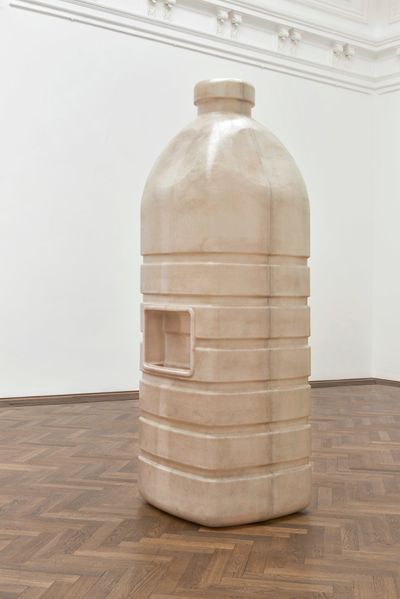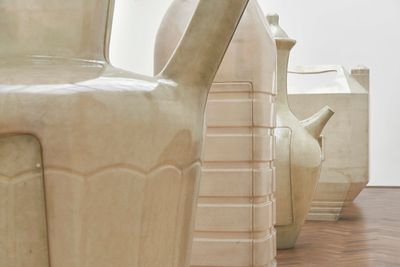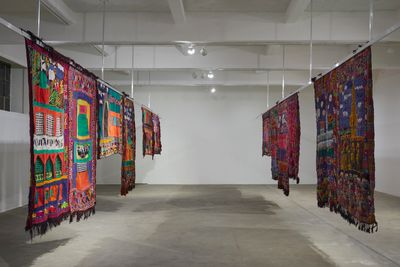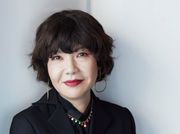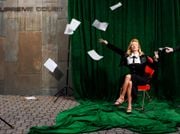Alia Farid: ‘The work I do is about looking beyond categories’
Alia Farid. Photo: Johanne Nyborg/Henie Onstad Kunstsenter.
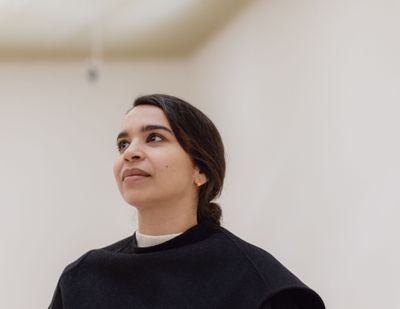
Alia Farid. Photo: Johanne Nyborg/Henie Onstad Kunstsenter.
Whether working with Samawa weavers in Iraq, fountain fabricators in Kuwait, or young residents of the Chibayish marshlands, Farid says, 'Much of the process is developing the craft together.'
Elsewhere (1 December 2023–4 February 2024), Alia Farid's solo show at Chisenhale Gallery in London, was the first presentation of a research project tracing Arab and South Asian migration to Latin America and the Caribbean.
In this iteration, Farid focused on the Palestinian diaspora in Puerto Rico, where she grew up. Opening the show was Gastronomía platos (Tierra Santa) (2023), a screenprinted photograph showing a tray of dishes on a table in Tierra Santa, a Palestinian-owned restaurant in San Juan, framed in the gallery's entrance.
Tierra Santa is depicted in one of the 16 hand-woven and embroidered rugs with earthy, red-scale tones that hang side by side, varying in length and width, in two parallel rows from the ceiling. Each rug draws on spaces defining Puerto Rico's Palestinian communities, including a mosque in Fajardo with a silhouette that echoes Jerusalem's Al-Aqsa Mosque, forming a cityscape in the main gallery.
Framing central images on the rugs are patterned borders constructed in the storytelling style of a kilim, include zig-zags, chevrons, floral tiles, cars, and other motifs. Some panels feature text alone, as in El Nilo (menú) (2023), which lists the menu of Puerto Rican dishes at Restaurante El Nilo over the heading, 'Comida Arabe' (Arabic food).
Each rug was created by weavers from Samawa in southern Iraq, using the techniques of flat weaving and chain stitching specific to the region, where Farid has worked before. For the 2022 Whitney Biennial, the artist filmed Chibayish in the Iraqi wetlands where the Tigris and Euphrates rivers meet.
Chibayish follows three young marsh inhabitants as they introduce the marshes and their ways of life. The result is a stunning portrait of a natural landscape shaped as much by intimate, communal ways of living as by war, resource extraction, and industrialisation.
The film connects to Farid's sculpture series In Lieu of What Is (2022): a row of five monumental resin and fibreglass casts of water vessels modelled after public drinking fountains in the Gulf, which were featured in Farid's solo show at Kunsthalle Basel in 2022, as well as in her Artes Mundi presentation last year.
Fabricated in Kuwait, vessels range from a South Asian lota to a classic plastic bottle, and a jerry can based on one the artist's grandmother brought back from Mecca. Together, they reference intersections of culture and trade that have defined the Arabian Peninsula, not to mention the distribution of natural resources. Namely oil, the discovery of which transformed the Gulf states, and water, whose scarcity has heightened tensions in the region exacerbated by the colonial borders that divided it, and created the need for ecologically destructive desalination plants.
Through her practice, Farid constantly seeks to release lands and communities from the artificial national borders that have sought to contain and expel them. All of which recalls one rug in Elsewhere, embroidered with the words 'Del río al mar, libre será andar': 'From the river to the sea, free it will be to roam'.
Farid intends to continue working on Elsewhere in Puerto Rico, while engaging with locations including Cuba, Trinidad, and Mexico—expanding a view of the world as a site of profound connection in the process.
In this conversation, Farid introduces the project and locates it within the context of her practice, ahead of a Lise Wilhelmsen Art Award solo exhibition at Henie Onstad Kunstsenter in Norway, opening in September.
SBYou conceived Elsewhere in 2013, yet you are presenting the first chapter now. How did the project develop?
AFThe project goes back to a conversation with a friend and artist Jesús "Bubu" Negrón. In 2012 to 2013, I was in Puerto Rico co-directing a space called Beta Local, where Bubu and many other artists gathered.
Bubu told me about his experience participating in the 2007 Sharjah Biennial, for which he created Cigarette Butt Street Rug, a paper carpet with filter fringes made with cigarette butts found in the local market, Souq Al Arsah. That project extended from a body of work Bubu had started in Old San Juan, where he filled cracks in the city's streets with cigarette butts picked from the sidewalks.
Bubu described the architectural forms he saw in Sharjah and their resonance with forms in Puerto Rico, including a building converted into a mosque in Ponce, where I'm from. We reflected on these connections and talked about the architectural forms that travel with transplanted communities, and began documenting these forms around the island.
Because these forms don't align with the touristic image of Puerto Rico, Bubu suggested we make postcards from our photographs. One postcard showed a mosque in Fajardo that resembles Al Aqsa in Jerusalem, which I reference in Elsewhere. When I told Bubu in 2021 that I wanted to continue the project on my own, he was supportive, and I successfully applied for a Creative Capital grant to develop it.
SBHow did you land on the form of the rug? Could you describe the process of creating them?
AFI chose textile for this project because there is no local tradition of landscape painting in the Arab world. There, landscape and place is something encountered mostly through carpets, rugs, and other textiles.
The composition of each piece is determined by the weavers. I met them while I was in Iraq filming Chibayish. I was on a boat, where a flat woven piece caught my attention. I was able to trace it back to the weavers I now work with, who are based in Samawa, not far from the marshes.
Together we organised a couple of workshops and storytelling sessions. I showed them photographs of the places I've documented in my research and shared stories. We made bundles for each tapestry that contained photographs of buildings and the surrounding environment. Samawa weavers generally do more abstract work repeating motifs, but not full-on landscapes.
There is a clear deviation from the traditional Samawa weaving style in this project. Sometimes elements or motifs converge. In the tapestry of the Jerusalem restaurant, for example, the windows are cladded with a type of iron work that is specific to the Caribbean. In the tapestry, the ironwork echoes an existing Samawa chainstitch. It's a nice moment where styles converge.
SBWhat you are describing is a kind of non-linguistic exchange through the process of making these works; a different kind of communication that takes place through the translation of forms...
AFI wouldn't say it's a translation, but rather a destabilisation of the relationship between objects and form, and writing and drawing. The project brings things into proximity, but without equating realities or situations.
What having connections to different regions really offers is multiple vantage points and the ability to see things from an outside perspective.
SBTo make your film Chibayish, you went without a script or a plan to the Iraqi marshlands and asked three young residents to show you around. Could you talk about that experience?
AFI didn't know what to expect crossing the border into Iraq. Everything about it was familiar and strange in equal measure. Basra [the port city in southern Iraq] is about a three-hour drive to the wetlands, so between Basra and Chibayish there is a difference in the way people live, but also a commonality.
SBI was struck by the buffalo calls in the film, especially given the violence that the marshlands have been subjected to, leading to the displacement of its indigenous communities. Yet many have returned, and many have retained their traditions.
AFIt's not so much tradition as it is a way of living—in the present; ongoing—not something recovered from the past. I think what makes the Iraqi marshes so profound is that it has endured everything you have just mentioned.
The Iraqi marshes have been drained and re-flooded since the mid-1900s. Underneath its subsoil are some of the biggest oil reserves in the world and the reason behind so much of its destruction. After decades of war, Iraq is a different place, but people still live there and that is what I'm focused on.
SBYou have described your way of working as 'emergent'. Given your engagement with communities for your films and sculptures, this approach seems to open up interesting possibilities around methods of communication and forms of exchange.
AFA lot happens in the workshopping stage of my work. In the marshes, for example, I spent a lot of time drinking tea and making drawings with the family that I stayed with. With the weavers, as well. We spent a lot of time looking at pictures and tapestries, and talking about things like colour, stitching, the frequency and meaning of motifs. Much of the process is developing the craft together.
SBHow has your way of working with craftspeople evolved? For example, how has your relationship with the fabricators in Kuwait, whom you worked with for In Lieu of What Is, changed since you first approached them?
AFFor the first set of vessels that I presented in 2019 at Portikus, I worked with a local company that makes drinking fountains, awnings, furniture, and other fibreglass and resin forms. I used existing moulds and selected shapes related to water from their catalogue of drinking fountains.
For my exhibition at Kunsthalle Basel in 2022, I worked with the same fabricators to create new moulds, like the jerry can based on one my grandmother brought back from Mecca.
We have developed a working relationship whereby we mutually learn from each other. You can imagine what it was like when I first approached them—especially in Kuwait, where people and spaces tend to be quite isolated. But it's been a wonderful process and nice to share the outcome of the work with them.
One thing the fabricators normally do with the drinking fountains is paint them. But I wanted the attention to be on the silhouette of the vessels, and what this says about production, and cultural and trade networks, so I purposefully removed the colour from the process.
For the fabricators, I think this made them feel the work was incomplete. But eventually they agreed to the natural resin and gave the vessels a beautiful finish. People sometimes think they are made from alabaster or stone, and I like that ambiguity. Their surfaces change a lot after they're freshly fabricated. They're quite translucent at first, then they turn more opaque.
SBIn Lieu of What Is references the historic connection between Basra and Kuwait, when water used to be transported along the Shatt al-Arab river. At that time, the borders between Iraq and Kuwait were more porous.
As with Elsewhere, which connects to your Caribbean roots, how does In Lieu of What Is extend your exploration of the confluences across the regions you are connected to?
AFThe vessels are an exploration of cultural and trade networks, past and present. They are based on vessel shapes that are 4000 years old, as well as modern translations of ancient vessels into plastic vessels.
. . . it's important to safeguard the space where you can think and work outside of the artworld dynamic . . .
I'm constantly observing and tracing forms of the material culture of a place, and making notes of things I see. It's in the tracing of these networks that I connect with the communities I work with.
People often interpret my work as being directly related to my own biography. There's a lot of emphasis on me being from the Caribbean and the Gulf. But what having connections to different regions really offers is multiple vantage points and the ability to see things from an outside perspective.
SBIn that sense, your work is about being in the world, and mediating the world as you naturally move through and negotiate it. I'm curious how that translates into an artistic position?
AFI spend a lot of time observing and trying to understand things. As a younger artist, I was often left out of regional exhibitions because I was neither Latin American nor Arab enough. It used to bother me, but now I think it's great that I am not bound to a region. The work I do is about looking beyond categories, and seeking other histories.
SBIt seems this experience as a young artist really defined your work's direction.
AFFor sure. I think being alone in the desert in Kuwait, where there is no art infrastructure, also really helped me make the work I just wanted to make. Of course it's helpful to have funding and support, but I think it's important to safeguard the space where you can think and work outside of the artworld dynamic, without any exhibition objectives. —[O]




